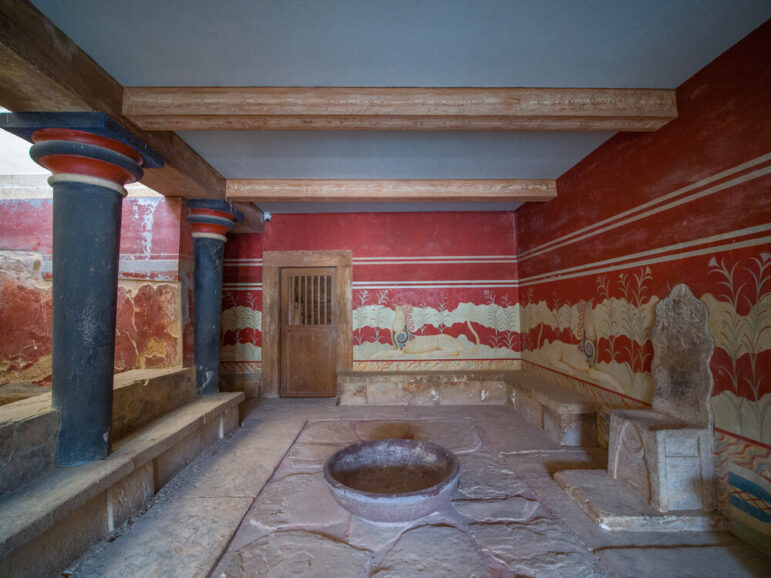Note: Stefano Ciotti contributed to this article
PARIS – The United Nations Educational, Scientific and Cultural Organization (UNESCO) World Heritage Committee began meeting on July 6, 2025, and on July 11, after months of deliberation, finalized the addition of 26 new properties to its prestigious World Heritage list. These additions bring the total number of sites recognized for their “outstanding universal value” to humanity to over 1,200, encompassing natural wonders, archaeological treasures, and cultural landscapes across the globe.
Among the newly inscribed sites are locations that resonate with practitioners of Pagan spiritualities, historians of ancient cultures, and advocates for Indigenous heritage. From the megaliths of Brittany to the fairy tombs of Sardinia, the 2025 additions highlight humanity’s enduring relationship with the land, the dead, and the sacred.

Flag of the United Nations Educational, Scientific and Cultural Organization (UNESCO) [Public Domain
Domus de Janas: Sardinia’s Fairy Houses Unearthed
One of the most celebrated additions is Italy’s Domus de Janas, or “fairy houses,” a series of rock-cut tombs carved into Sardinian bedrock more than 5,000 years ago. Scattered across the island, approximately 3,500 of these pre-Nuragic structures form the largest and richest network of underground funerary architecture in the western Mediterranean.
According to Sardinian legend, the tombs were homes to the Janas, small fairylike beings. In reality, these hypogea served as burial chambers for early islanders between the 5th and 3rd millennium BCE. Each site reflects the spiritual beliefs, social hierarchies, and funerary customs of a community transitioning toward complex social organization.
Notable locations include Montessu, with 35 tombs arrayed like an amphitheater, and S’Incantu, near Alghero, whose multi-roomed painted tombs resemble Neolithic huts. The Sant’Andrea Priu necropolis impresses visitors with massive domus like the Tomb of the Chief, which spans 250 square meters. Sites such as Sas Concas and Anghelu Ruju offer additional insights, with symbolic engravings—including upside-down human forms—and even ancient stone tools left behind by the builders.

Domus de Janas de Monte Arista (necropolis) near Cardedu, Sardinia. Rock with several tombs. Photo Credit: Thiotrix CCA-SA 4.0]
Carnac Megaliths: France’s Neolithic Enigma Enshrined
In neighboring France, UNESCO has honored the Megaliths of Carnac and the Shores of Morbihan, a massive serial property in Brittany. This area contains the world’s most extensive collection of Neolithic standing stones—over 3,000 in total—arranged in alignments, circles, dolmens, and burial mounds dating back to 4500–3300 BCE.
The main alignments of Ménec, Kermario, Kerlescan, and Le Petit Ménec continue to mystify archaeologists and spiritual seekers alike. Theories about their purpose range from astronomical observatories to religious pilgrimage sites or ancestor monuments. Rich engravings and artifacts found in the area reveal a sophisticated understanding of natural and spiritual environments, further linking the stones to early ceremonial life along Europe’s Atlantic rim.
Breton folklore adds a mythical dimension: some locals claim the stones are petrified Roman soldiers cursed by druids. Due to concerns about degradation, visitor access is now largely restricted to guided tours.

The famous neolithic menhirs near Carnac, Brittany, France [Karsten Wentink, Wikimedia Commons, CC 4.0]
Minoan Palatial Centers: Crete’s Ancient Hubs of Power and Faith
Greece’s Minoan Palatial Centres were also recognized as a serial site, comprising six archaeological complexes across Crete. These Bronze Age structures (c. 1900–1100 BCE) reflect the height of Minoan civilization—an early Mediterranean culture known for its maritime trade, artistry, and matriarchal religious symbols.
Palaces such as Knossos, Phaistos, Malia, Zakros, and Kydonia were not merely royal residences but served as economic, spiritual, and political hubs. Elaborate frescoes, indoor plumbing, storage rooms, and central courtyards reveal an advanced society with a redistributive economy and extensive religious rituals. While these centers lacked defensive walls, their sudden collapse around 1450 BCE may have been due to natural disasters or Mycenaean conquest.

Knossos palatial centre. The Throne Room [Photo Credit: Greek Ministry of Culture – Courtesy
Murujuga Cultural Landscape
The Murujuga Cultural Landscape, located in Western Australia’s Pilbara region, is home to one of the largest and most significant collections of ancient Indigenous rock art (petroglyphs) in the world. The name Murujuga comes from the language of the local Ngarluma people and refers to what is also known as the Burrup Peninsula.
The site contains over one million rock engravings, some of which date back more than 40,000 years, making it an exceptional record of human artistic and cultural expression. The artwork includes depictions of human figures, animals (like kangaroos, emus, and turtles), extinct species such as the thylacine (Tasmanian tiger), and abstract geometric shapes.
Murujuga is not only a repository of visual heritage but also a sacred living cultural landscape for the Traditional Owners, including the Ngarluma, Yaburara, Mardudhunera, and Wong-Goo-Tt-Oo peoples. The petroglyphs reflect their spiritual beliefs, creation stories, and long-standing connection to the land.
Routes Across the Globe
UNESCO’s 2025 list also emphasizes Indigenous and prehistoric heritage. Among the most spiritually significant is Mexico’s Wixárika Route through Sacred Sites to Wirikuta, a pilgrimage trail maintained by the Wixárika (Huichol) people. Winding through the Sierra Madre Occidental to the Wirikuta desert, this route links sacred mountains, springs, and temples in a living tradition that embodies Indigenous cosmology and identity.
In Russia, the Shulgan-Tash Cave—also called Kapova Cave—was added for its Ice Age art: Paleolithic paintings of mammoths, horses, and symbols estimated to be 17,000 years old. The cave blends natural beauty with spiritual imagery carved by prehistoric artists.
South Korea’s Petroglyphs along the Bangucheon Stream show animals, rituals, and daily life from the Neolithic to early historic periods, offering a window into Korea’s ancient animistic beliefs.
The Faya Palaeolandscape in the UAE, meanwhile, preserves evidence of early human migration out of Africa. Archaeological layers show continuous occupation and movement dating back over 200,000 years.
Turkey’s Sardis and the Lydian Tumuli of Bin Tepe spotlight the ancient Lydian capital and its monumental burial mounds—most famously, the tomb of King Alyattes. The city was once a hub of early coinage and cultural fusion between Anatolia and the Hellenic world.
Other Sites Inscribed in 2025
The full list of newly designated World Heritage Sites spans continents and traditions, including:
-
Cambodian Memorial Sites – Former Khmer Rouge detention and execution centers
-
Xixia Imperial Tombs (China)
-
Palaces of King Ludwig II (Germany) – Including Neuschwanstein and Linderhof
-
Maratha Military Forts (India)
-
Khorramabad Valley Prehistoric Sites (Iran)
-
Port Royal (Jamaica)
-
Mount Mulanje Cultural Landscape (Malawi)
-
Colonial Transisthmian Route (Panama)
-
Ancient Khuttal Heritage Sites
-
Forest Research Institute Malaysia Forest Park Selangor
-
Peruaçu River Canyon (Brazil)
-
Møns Klint Chalk Cliffs (Denmark)
-
Bijagós Archipelago Ecosystems (Guinea-Bissau)
-
Gola Tiwai Complex (Sierra Leone)
-
Mount Kumgang (Diamond Mountain) (North Korea)
By adding these 26 sites, UNESCO continues its mission to protect the most valuable cultural and natural heritage across the globe. These sacred tombs, rock carvings, ancient cities, and biodiverse landscapes are not only vital to understanding human history—they also serve as living bridges between ancestral knowledge and contemporary identity while also celebrating the sacredness of the Earth and the memory of the ancestors.
The Wild Hunt is not responsible for links to external content.
To join a conversation on this post:
Visit our The Wild Hunt subreddit! Point your favorite browser to https://www.reddit.com/r/The_Wild_Hunt_News/, then click “JOIN”. Make sure to click the bell, too, to be notified of new articles posted to our subreddit.